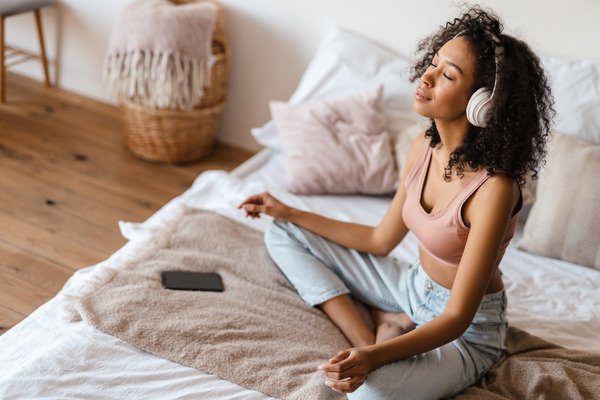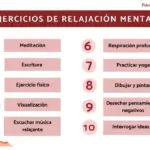
Self-hypnosis is a form of relaxation that helps connect with the subconscious to achieve the changes we seek in our mind and thoughts. The idea is that, through this relaxation, the barriers we have in our minds that prevent us from making changes are relaxed. We would change our belief system and the way we react to different situations.
Do self-hypnosis and meditation have anything in common? Does self-hypnosis help to lose weight? For many, talking about hypnosis and self-hypnosis implies something magical and an unbreakable formula. However, that is not the case. It requires a great effort on the part of the person since it would try to change the most deeply rooted associations in our brain between situation-thought-behavior/emotion. To know more in depth about What is self-hypnosis, how it is done and its benefits continue reading PsychologyFor.
What is self-hypnosis?
Hypnosis, and therefore self-hypnosis, is based on the theory that behaviors are created in our brain by repetition. That is to say, By acting several times in the same way in a situation, we end up automating said behavior. Therefore, what is intended with self-hypnosis is that, through a state of deep relaxation, the person can see themselves acting differently in certain circumstances until said behavior arises automatically.
- For example, by repeatedly visualizing yourself on a break from work without smoking, the person will stop automating said action because they have mentally become “unused” to performing it.
The disadvantage of self-hypnosis compared to classic hypnosis is that the second is more objective by having a person control the process and help the person deal with different obstacles. Furthermore, there is a difference between the results of hypnosis practiced by an expert and hypnosis practiced by a person who has never practiced it.
What is self-hypnosis for?
Does self-hypnosis help you lose weight? Can self-hypnosis help you sleep soundly? Let’s see how much truth there is in these ideas. Self-hypnosis can be used to solve or alleviate different problems. Some of them are:
- Fight certain addictions like nail biting or smoking. Therefore, self-hypnosis can also help you quit smoking.
- Correct bad eating habits like eating between meals, so it can help with weight loss. That is, self-hypnosis can be a complementary technique that helps you lose weight.
- minor fears such as public speaking, as some phobias would require supervision.
- Motivation and focus on objectives.
- Falling asleep since self-hypnosis serves as relaxation to sleep deeply.
- Self-esteem problems. Another benefit of self-hypnosis is to improve self-esteem.
How to do self-hypnosis: 3 techniques
How to do self-hypnosis? Once we have seen what self-hypnosis is and the benefits it can have, we are going to explain what the self-hypnosis techniques. There are various techniques for performing self-hypnosis. Next, we will see what they consist of and how some of them would be applied:
Display
- With this self-hypnosis technique we would use an imaginary place that gives us peace or a specific point in our house through which it is easy for us to feel calm.
- Breathing should be slow and deep and we should feel how the muscles get heavier and heavier. Meanwhile, our mind remains focused on that peaceful place.
- Think about what the aroma of that place is like, what sounds there are, what every detail is like…
- Once you feel completely relaxed, it is time to introduce the modification that interests us. This can be an image such as seeing ourselves speaking in public without difficulty or eating healthily, for example, or through positive messages such as “I will be happier”, “I will get a new job”. …
Here you will find more information about the visualization technique.
Fixation
- In the case of this self-hypnosis technique, to achieve that state of relaxation that allows us to send ourselves these messages and implant them in our mind, we would focus our gaze just above our eyes, so that a blurring occurs.
- As we achieve this, our breathing must be, again, it must be slow and deep.
- Once this state of relaxation is achieved, as in the visualization technique, we would transmit that desired image or message to ourselves.
Breathing
- In this case, the breath is the only place we will focus on. The ideal is to always perform self-hypnosis in the same place, so that said place ends up being associated with calm.
- Slow, deep breaths would be taken, with a few seconds of air retention in our lungs.
- Once we reach the state of calm, the desired message would be introduced into our mind again. It must be taken into account that the messages must be positive. It would not be useful to repeat to ourselves “I am not going to smoke”, it is better, directly, to observe ourselves through our imagination without doing so. In the same way, it is better to repeat to ourselves “I am going to eat healthy” rather than “I am not going to eat a pizza.”
Learn other breathing exercises to relax.
Finally, we must keep in mind that consistency is the key to success. You have to repeat this action over and over again for it to be effective, since just one practice will not produce results. The ideal would be do these exercises daily at least once, taking into account that the more we do it, the greater the benefits will be.
This article is merely informative, at PsychologyFor we do not have the power to make a diagnosis or recommend a treatment. We invite you to go to a psychologist to treat your particular case.
If you want to read more articles similar to What is self-hypnosis and how is it done? we recommend that you enter our Personal Growth and Self-Help category.
Bibliography
- Alman, B.M., & Lambrou, P. (2013). Self-hypnosis: the complete manual for health and self-change. Routledge.
- Young, P. (2016). Personal change through self-hypnosis. Fontaine Press Pty Ltd.








